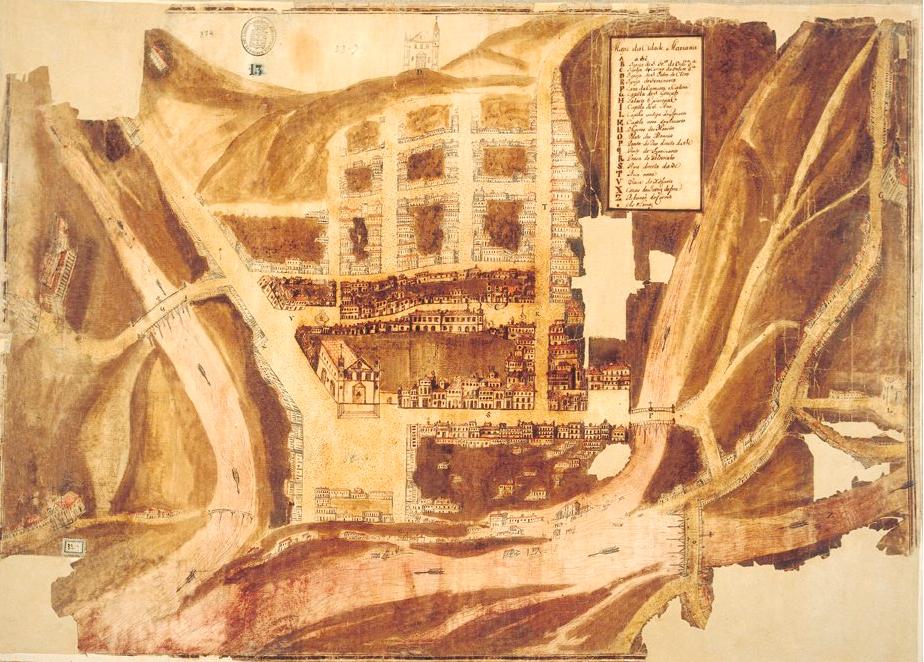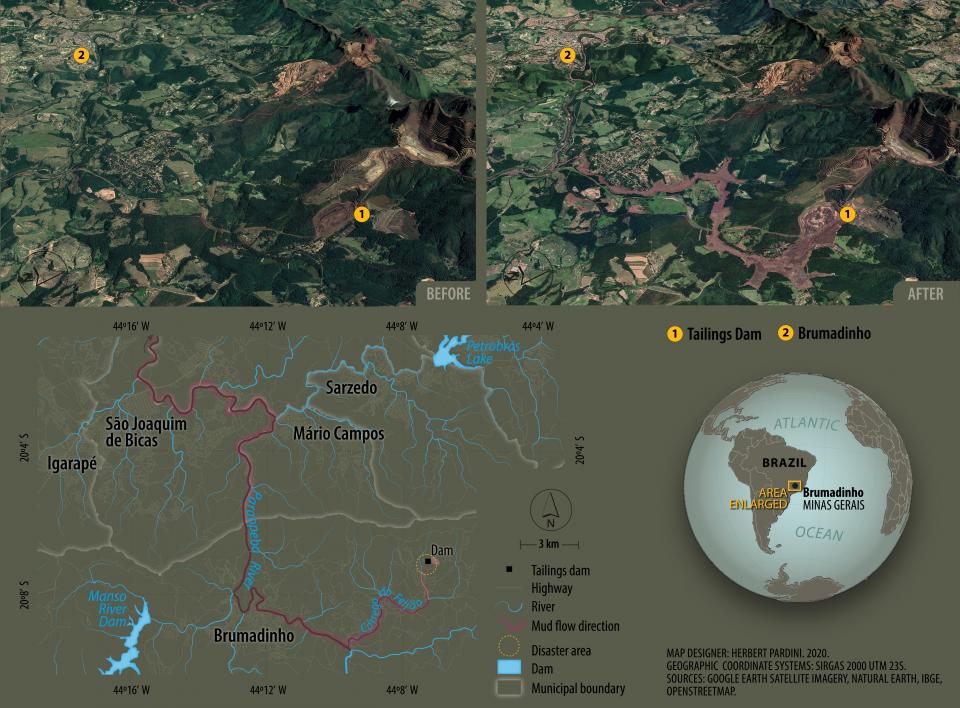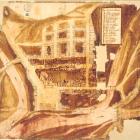In November 2015, a tailings dam for iron ore mining collapsed in Brazil, causing one of the country’s greatest socio-environmental disasters. The Fundão Dam, as it was known, belonged to Samarco Mineração SA’s industrial complex, controlled by the multinationals Vale SA and BHP Billiton, and was located in Mariana, Minas Gerais.
Its collapse released approximately 45 million cubic meters of mud, causing a wave of devastation that reached Rio Doce’s watershed rivers, going as far as the Atlantic Ocean over 650 kilometers from where the disaster took place (Figure 1). Nineteen people lost their lives, as well as thousands of trees, animals, and microorganisms. Field crops, houses, urban structures, and all of the Bento Rodrigues district, in the town of Mariana, were destroyed.

Fig. 1. Representations, at different scales, of the disaster caused by the collapse of the Fundão Dam in Mariana, Minas Gerais (2015). Click two times for full resolution.
Fig. 1. Representations, at different scales, of the disaster caused by the collapse of the Fundão Dam in Mariana, Minas Gerais (2015). Click two times for full resolution.
Map by Herbert Pardini, 2021.
 This work is licensed under a Creative Commons Attribution-NonCommercial-NoDerivatives 4.0 International License.
This work is licensed under a Creative Commons Attribution-NonCommercial-NoDerivatives 4.0 International License.
Looking at history it is possible to see that the negative consequences of mining have been endured since the first decades of mineral exploration in Brazil. In the mid-eighteenth century, Ribeirão do Carmo—which suffered the impacts of the 2015 dam collapse—was already filled with gold mining waste, causing floods in Mariana.
Throughout the 1730s and 1740s, the floods became the focus of discussions and power struggles among different local elite individuals of the town, and a few historical documents clearly show mining as their main reason. This is what is seen in the records of a conflict, which began in 1743, between two rich miners and Mariana’s Câmara or Council Chamber.
Council Chambers were local administrative institutions of power composed of members of the elite: white individuals with better economic and social prospects. But the interests of the members of the Council Chambers didn’t always represent the interests of the rest of the population who had power in that society. The two miners who clashed with the institution were also members of the local elite and were being accused of causing floods with their mining services.
In that historic moment, in which Mariana had just received the status of town, the Council Chamber was worried about keeping the territory compatible with the “civilized” standards of the town category, and the floods were seen as obstacles to reaching this goal, since they destroyed buildings, religious temples, and public ways in the urban center, as represented in Figure 2.

Fig. 2. Map of the city of Mariana showing, in the bottom part, one of the floods that afflicted the city in the eighteenth century,
Fig. 2. Map of the city of Mariana showing, in the bottom part, one of the floods that afflicted the city in the eighteenth century,
Cartographer unknown, n.d.
Itamaraty’s Map Library, Rio de Janeiro. MI (in. 874).
 This work is licensed under a Creative Commons Public Domain Mark 1.0 License.
This work is licensed under a Creative Commons Public Domain Mark 1.0 License.
It was in this context that the members of the Council Chamber accused the aforesaid miners of causing the floods. The intention of the institution was to dispossess the miners of their mining land to end the urban problems they caused. However, the two defendants were men of great economic and social standing and, at the end of the conflict, they were favored by the king’s decision to let them keep the ownership of their mining lands.
Even if we focus on the historic peculiarities of each period, it is impossible not to establish a comparison between the events of the present and the past. It is not just a question of equating them, but to comprehend the similarities between them. In the eighteenth century, disputes caused by the floods in Mariana led to decisions that favored the conservation of gold extraction activities in the town, even if they caused negative impacts and damaged urban life.
The same can be said about the current scenario. In 2017, two years after the dam collapse in the town of Mariana, the Minas Gerais State Board of Environmental Policies published a Normative Deliberation which lowered the environmental licensing criteria for operations and activities that use environmental resources in Minas Gerais. This measure has been considered by experts as one of the responsible factors for another great disaster in Brazil’s mining sector: the collapse of another tailings dam—also controlled by Vale SA—in the town of Brumadinho, Minas Gerais, in 2019. In this catastrophe, 259 human lives were lost, as well as thousands of non-human lives, and 11 people are missing (Figure 3).

Fig. 3. Representations, at different scales, of the disaster caused by the collapse of tailings dam in Brumadinho, Minas Gerais (2019). Click two times for full resolution.
Fig. 3. Representations, at different scales, of the disaster caused by the collapse of tailings dam in Brumadinho, Minas Gerais (2019). Click two times for full resolution.
Map by Herbert Pardini, 2020.
 This work is licensed under a Creative Commons Attribution-NonCommercial-NoDerivatives 4.0 International License.
This work is licensed under a Creative Commons Attribution-NonCommercial-NoDerivatives 4.0 International License.
Even though the historic individuals involved in mineral exploration in the eighteenth century (individual/associated explorers and slave workers) and in the twenty-first century (multinational companies and free workers) are different, there’s a clear similarity in the choices made in the past and still made in the present, such as maintaining primacy of the elite’s interests and the option of continuing mining activities at any cost, even when they put lives at risk. The two cases indicate the persistent coloniality that affects Latin American nature. As Héctor Alimonda writes, nature “is viewed by global hegemonic thought and regional elites as subaltern space that can be exploited, obliterated or reconfigured, according to the needs of the current accumulation regime.”
In the past, the king’s decision favored the continuation of mining in Mariana’s urban space despite all the damage it caused to the individuals living there. Obviously, the Crown was interested in the profits this activity guaranteed them. In the present, even though the iron ore mining is led by multinational companies, the Brazilian State still positions itself in their favor. After all, mining does not only serve the interests of big international corporations, but also the interests of public institutions themselves and the people who occupy positions in them, often benefitting from the resources stemming from this activity, such as the financing of campaigns and royalty payment. And so it is perpetuated in time as a colonialist project that supports the expansion of the financial and commercial system of the capitalist world economy, despite the socio-environmental costs.
How to cite
Capanema, Carolina. “Mining and Environmental Destruction in Minas Gerais: A Historical Comparison.” Environment & Society Portal, Arcadia (Spring 2021), no. 6. Rachel Carson Center for Environment and Society. doi:10.5282/rcc/9217.
ISSN 2199-3408
Environment & Society Portal, Arcadia
 This work is licensed under a Creative Commons Attribution 4.0 International License.
This work is licensed under a Creative Commons Attribution 4.0 International License.
2021 Carolina Capanema
This refers only to the text and does not include any image rights.
Please click on an image to view its individual rights status
- Alimonda, Héctor. “La colonialidad de la naturaleza: una aproximación a la Ecología Política latinoamericana.” In La Naturaleza colonizada: ecología política y minería en América Latina, edited by Héctor Alimonda, 20–54. Buenos Aires: CLACSO, 2011.
- Capanema, Carolina. A natureza política das Minas: mineração, meio ambiente e sociedade no século XVIII. Belo Horizonte: Editora Letramento, 2019.
- Conselho Estadual de Política Ambiental (COPAM), Minas Gerais. “Deliberação Normativa Copam no. 217, de 6 de dezembro de 2017.” Accessed 14 April 2020. http://www.siam.mg.gov.br/sla/download.pdf?idNorma=45558.
- Milanez, Bruno, Lucas Magno, and Raquel Giffoni Pinto. “From Weak Politics to Private Policies: The Role of the Mining Sector in the Transformations of Environmental Policy in Minas Gerais State, Brazil.” Cadernos de Saúde Pública 35, no. 5, 2019: e00051219. doi:10.1590/0102-311x00051219.
- Ramboll Brasil. “Avaliação do programa de reparação integral da Bacia do Rio Doce.” Accessed 1 February 2021. http://jornalasirene.com.br/wp-content/uploads/2018/11/RBLRamboll_Report_Projeto_Definitivo__A4_28.03.18.pdf.
- Representação dos oficiais da Câmara da cidade de Mariana, expondo o dano que lhes advém do serviço de minerar pertencente a Antônio Botelho e seu irmão João Botelho de Carvalho, instalado na praia do Rio, do qual provêm as inundações da cidade e solicitando provisão régia para que esse serviço seja interdito de assentar no referido local. 25 September 1745. Arquivo Histórico Ultramarino, Avulsos da Capitania de Minas Gerais, box 45, doc. 92.
- Tedeschi, Denise. Águas Urbanas: as formas de apropriação das águas nas Minas: século XVIII. São Paulo: Alameda Editorial, 2014.








